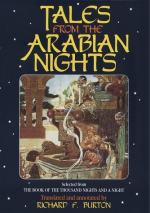History of the Lovers of Syria (pp. 13-26).
P. 18.—Divination by the flight or song of birds is so universal that it is ridiculous of Kreutzwald (the compiler of the Kalevipoeg) to quote the fact of the son of Kalev applying to birds and beasts for advice as being intended by the composers as a hint that he was deficient in intelligence.
In Bulwer Lytton’s story of the Fallen Star (Pilgrims of the Rhine, ch. xix.) he makes the imposter Morven determine the succession to the chieftainship by means of a trained hawk.
P. 26, note 2.—Scott may possibly refer to the tradition that the souls of the dead are stored up in the trumpet of Israfil, when he speaks of the “receiving angel.”
History of Al-hajjaj Bin Yusuf
and the Young Sayyid
(pp. 26-44).
P. 30, note 2.—I doubt if the story-teller intended to represent Al-Hajjaj as ignorant. The story rather implies that he was merely catechising the youth, in order to entangle him in his talk.
P. 33.—Compare the story of the Sandal-wood Merchant and the Sharpers (Nights, vi. p. 206) in which the Merchant is required to drink up the sea [or rather, perhaps, river], and requires his adversary to hold the mouth of the sea for him with his hand.
P. 38, note 1.—It is well known that children should not be allowed to sleep with aged persons, as the latter absorb their vitality.
Night Adventure of Harun Al-rashid
and the Youth Manjab
(pp. 45-80).
P. 77.—In the Danish ballads we frequently find heroes appealing to their mothers or nurses in cases of difficulty. Compare “Habor and Signild,” and “Knight Stig’s Wedding,” in Prior’s Danish Ballads, i. p. 216 and ii. p. 339.
Story of the Darwaysh and the Barber’s Boy and the Greedy Sultan (pp. 80-88).
This story belongs to the large category known to students of folk-lore as the Sage and his Pupil; and of this again there are three main groups:
1. Those in which (as in the present instance) the two remain on friendly terms.
2. Those in which the sage is outwitted and destroyed by his pupil (e.g., Cazotte’s story of the Maugraby; or Spitta Bey’s tales, No. 1).
3. Those in which the pupil attempts to outwit or to destroy the sage, and is himself outwitted or destroyed (e.g., The Lady’s Fifth Story, in Gibb’s Forty Vezirs, pp. 76-80; and his App. B. note v., p. 413).
The Loves of Al-hayfa and Yusuf (pp. 93-166).
P. 114, note 4.—I believe that a sudden attack of this kind is always speedily fatal.
The Goodwife of Cairo and Her
Four Gallants (pp.
193-217).
P. 194, note 2.—It may be worth while to note that Swedenborg asserts that it is unlawful in Heaven for any person to look at the back of the head of another, as by so doing he interrupts the divine influx. The foundation of this idea is perhaps the desire to avoid mesmeric action upon the cerebellum.




